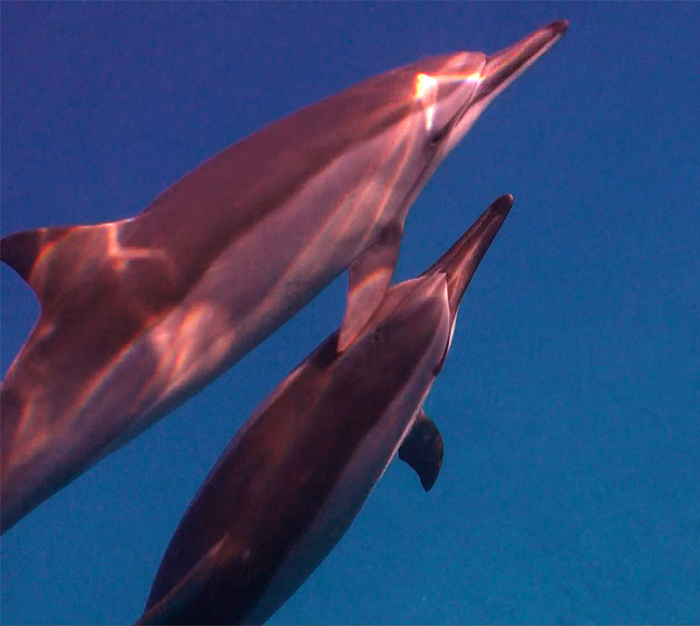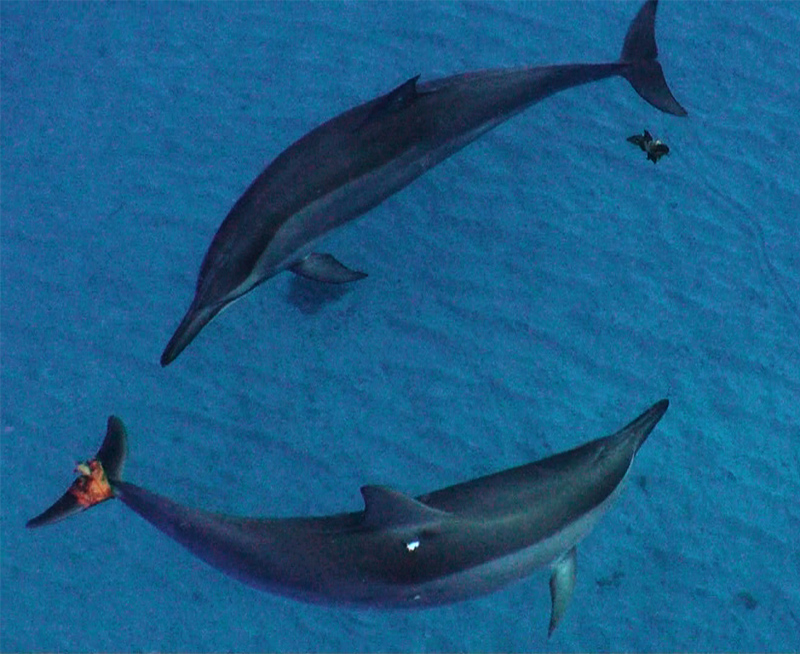‘One Dolphin Day On Earth’ is our contribution to the One Day On Earth project which gathers videos from around the world, shot on the same day, to chronicle life on our planet. On this year’s date, 11/11/11, the Dolphin Dance Project was engaged in an extended period of rehearsals with wild Pacific Spinner Dolphins, and so by fortunate coincidence, we can offer a glimpse into a typical morning of their daily lives.
If the video does not play smoothly, please watch on Youtube
The One Day On Earth project reaches out to every country of the world (with help from the UN) to gather video contributions, all of which are made available online in a giant searchable database. The filmmakers then sift the materials into a powerful feature length portrait of a typical day on earth. Their first film, made from footage shot on 10/10/10, will premiere at the UN and around the world in every country on Earth Day (April 22) this year. We met one of the organizers, Cari Ann ShimSham* (at the Dance on Camera festival in NYC), and we were honored she invited us to contribute the video we shot.
Of course, we thought it would be important to use the opportunity to represent the dolphins’ perspective. Like us, they have rich cognitive and emotional lives expressed through all kinds of relationships with other members of their pod, their close friends, their family and even other species (primarily other dolphins and whales, but occasionally a Homo sapiens or two). Each dolphin has a point of view as meaningful as any of our own to the story of each day on earth, and as we consider it, we are reminded of all the creatures of the ocean who live their lives in parallel to ours.
For the Pacific Spinner dolphins in our video, the daytime is when they rest. After an active night of catching fish in deep water miles off shore, they return to shallow coves in the early morning to socialize and then to rest during the middle of the day before rousing each other in the late afternoon for the next foray.
As you see in the video, they can have a lot of energy after filling their bellies all night. Because dolphins are so well adapted to their environments and catch fish so efficiently, they have plenty of leisure time in their daily activities in addition to finding food and sleeping. Their social time is very important: they invest in their friendships, workout conflicts, provide safe play and learning time for the young, and all the other things that allow a pod of individuals that are completely dependent on each other to remain close knit.
This social time is also generally the polite moment for us to ask for a dance. If someone is interested, we will begin a movement conversation, which builds as an improvised dance. On this particular day, we were introducing a new dancer, Jillian Rutledge, and the dolphins spent most of their time showing us how to play with leaves.
It is easy to refer to ‘the dolphins’ as if they all resemble each other, but each one is uniquely individual. Although it can be hard for us to distinguish them visually, their distinct personalities express themselves in different styles of playing with leaves, or degrees of interest in meeting humans. Fortunately, some have distinguishing features that are easy for us to identify underwater. One dolphin, featured in the video and recognizable by the two white marks on his flank near his dorsal fin, we call ‘Sirius‘. As you can see in this short portrait, he has a passion for leaves and engaging his friends in leaf play (which even includes the camera person).
By the late morning, it is time for the dolphins to rest, and they settle in for 6 to 8 hours of drifting together (well, it looks like drifting, but they are still going faster than any human can swim), coming up for occasional breaths. Dolphins sleep with only one half of their brain at a time, so you can see in the video that even while resting, they may say hello to the camera person as they rise to the surface. Mommas watch their babies, friends keep an eye on each other, the pod stays connected almost silently, as they flow together in beautiful, peaceful harmony.
Joyful and lovely dolphin days like this are under constant threat from our ever expanding impact on the environment and the oceans in particular. On the one hand, boat traffic and noise and eager tourists can make it difficult for dolphins to get the rest they need. On the other hand, industrial fishing depletes the fish stocks on which dolphins depend. The decimation is not just to the fish we eat, since bycatch (fish that are killed but not kept) can amount to 25% of the haul. What is worse, dolphins are often part of that bycatch, as much in carelessly discarded nets and fishing lines as in working gear. The World Wildlife Foundation has estimated that as many as 1,000 whales, dolphins, and porpoises die each day in nets and fishing gear.
These are just a few of the many ways that our societies impact the lives of dolphins. To learn more about the threats they face, and what we can do about them, please visit our Protect page.
When we take into consideration our impact on the dolphins, and make even small changes in the choices we make, we can make a positive difference in the life of a dolphin. Like us, each dolphin has his or her own, unique, irreplaceable experience of each day on earth: every dolphin life matters.
Posted by Benjamin Harley



